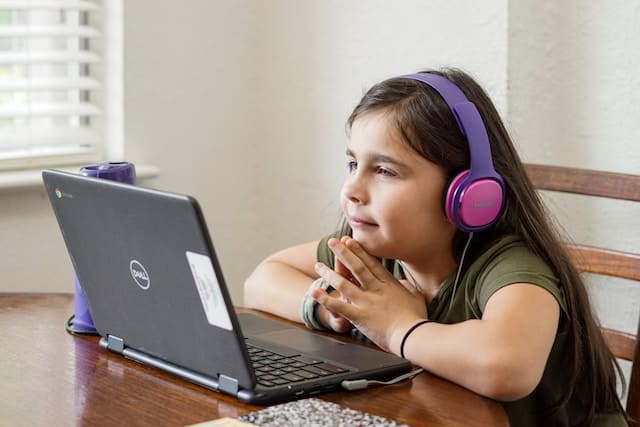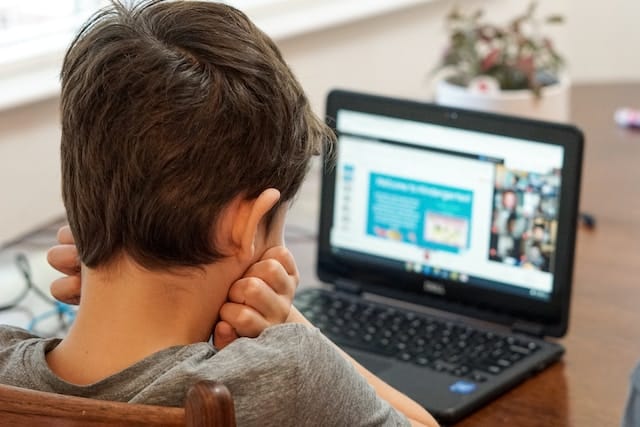In today’s digital landscape, where children are increasingly exposed to the vast world of the internet, the role of parents in teaching online safety has become paramount. With the constant evolution of technology comes the emergence of new risks and dangers that children may encounter online. Consequently, it is essential for parents to actively engage in their child’s online activities and take proactive measures to ensure their safety.
This article aims to explore the multifaceted aspects of parental involvement in teaching online safety, including the significance of communication with children and the necessity of monitoring their online interactions. By fostering open lines of communication and establishing trust, parents can guide their children in navigating the digital world responsibly and mitigating potential risks.

Through consistent monitoring, parents can identify threats or inappropriate content and take appropriate action. Ultimately, parents play a vital role in shaping their children’s digital citizenship and ensuring their overall well-being in the digital realm.
Setting Boundaries and Establishing Rules
When it comes to teaching online safety, parents play a crucial role in setting boundaries and establishing rules for their children. Parental guidance is essential in ensuring online safety for kids and promoting responsible digital parenting. Setting boundaries and establishing rules help children navigate the digital world effectively while minimizing potential risks.
One important aspect of setting boundaries is open communication with children. Parents should have regular conversations with their kids about the importance of online safety and the potential dangers they may encounter. It is crucial to create an environment where children feel comfortable discussing their online experiences and concerns.
Establishing rules is another key aspect of teaching online safety. Parents should set clear guidelines regarding the usage of devices, internet access, and the types of content that are appropriate for their children. These rules should be age-appropriate and take into consideration the child’s maturity level and understanding of online risks.
Monitoring online activities is also vital in ensuring children’s safety online. Parents should have access to their children’s devices, social media accounts, and browsing history. This allows them to keep an eye on their online interactions, identify potential threats, and address any concerning behavior promptly.
Open and Ongoing Communication
Parents should engage in regular, open, and ongoing communication with their children to effectively teach online safety. Open communication creates a safe and supportive environment where children feel comfortable discussing their online experiences, concerns, and questions. By maintaining an ongoing dialogue, parents can stay informed about their children’s online activities and help them navigate potential risks.
Regular conversations about online safety allow parents to educate their children on the importance of privacy, responsible online behavior, and the potential dangers they may encounter. It is crucial for parents to establish trust and encourage their children to share any uncomfortable experiences or encounters they may have had online. By doing so, parents can provide guidance, address concerns, and prevent potential harm.
Open communication also helps parents monitor their children’s online activities more effectively. By having open conversations about the websites they visit, the people they interact with, and the content they consume, parents can identify any red flags or signs of inappropriate behavior. This information enables parents to take necessary actions, such as implementing stricter parental controls or discussing the potential risks with their children.

Educating About Online Risks and Consequences
When it comes to educating children about online risks and consequences, it is essential for parents to provide real-life examples of the potential outcomes. This can help children understand the seriousness of their actions and the impact it can have on their lives.
Additionally, discussions about age-appropriate risks and building digital resilience can empower children to make informed decisions and navigate the online world safely.
Real-Life Examples of Consequences
By providing real-life examples of consequences, parents play a crucial role in educating their children about the risks and consequences of online activities. These examples help children understand the potential dangers and encourage them to make responsible choices when using the internet.
For instance, parents can share stories of individuals who fell victim to online scams or cyberbullying, highlighting the negative impact it had on their lives. They can also discuss cases where inappropriate sharing of personal information led to identity theft or online harassment.
Age-Appropriate Risk Discussions
Effective education about online risks and consequences involves engaging in age-appropriate discussions with children. It is crucial for parents to have open conversations with their children about the potential dangers they may encounter online. By providing them with the necessary information, parents can help their children make informed decisions and develop the skills needed to navigate the online world safely.
Here are five important points to consider when discussing online risks with children:
- Explain the concept of online privacy and the importance of keeping personal information secure.
- Discuss the potential risks associated with sharing photos and videos online, emphasizing the need to think before posting.
- Teach children about the dangers of engaging with strangers online and the importance of not sharing personal information with unknown individuals.
- Emphasize the potential consequences of cyberbullying and the importance of treating others with respect and kindness online.
- Encourage children to come to you if they encounter something online that makes them uncomfortable or if they have any concerns about their safety.
Building Digital Resilience
One key aspect of teaching online safety is educating children about the risks and consequences they may face while using the internet. Building digital resilience is crucial in helping children understand the potential dangers and develop skills to navigate online spaces responsibly. By fostering digital resilience, parents can empower their children to make informed decisions and handle online risks effectively.
To educate children about online risks and consequences, parents can use the following table as a guide:
| Risk | Consequence |
|---|---|
| Cyberbullying | Emotional distress, low self-esteem, social isolation |
| Inappropriate content | Exposure to explicit or harmful material, desensitization |
| Online predators | Grooming, exploitation, endangerment |
| Privacy breaches | Identity theft, online scams, reputation damage |
| Cyberstalking | Fear, invasion of privacy, harassment |
| Malware and phishing | Data theft, financial loss, compromised devices |
Teaching Responsible Online Behavior
Parents play a crucial role in instilling responsible online behavior in their children. In today’s digital age, it is essential for parents to guide their children in navigating the online world responsibly and safely. Here are five key strategies parents can use to teach responsible online behavior:
- Establish clear rules and boundaries: Set clear expectations for your child’s online behavior, such as time limits, appropriate content, and respectful communication. Reinforce these rules consistently to help your child understand the importance of responsible online conduct.
- Encourage open communication: Create a safe and non-judgmental environment where your child feels comfortable discussing their online experiences. Encourage them to share any concerns, issues, or encounters they may have had while using the internet. This way, you can address any potential risks or inappropriate behavior promptly.
- Lead by example: Children are more likely to emulate their parents’ behavior. Therefore, it is crucial for parents to model responsible online behavior themselves. Practice healthy digital habits, such as using privacy settings, being cautious about sharing personal information, and engaging in respectful online discussions.
- Educate about online risks: Teach your child about the potential risks associated with the internet, such as cyberbullying, phishing, and online predators. Help them understand how to identify and avoid these risks, as well as how to react if they encounter them.
- Monitor and supervise: Regularly monitor your child’s online activities and be aware of the platforms, apps, and websites they are using. Utilize parental controls and monitoring software to ensure their safety. However, it is also important to respect their privacy and foster trust by discussing the importance of monitoring openly.
Monitoring Online Activities and Privacy Settings

In ensuring the safety of their children online, parents should actively monitor and manage online activities and privacy settings.
Monitoring online activities is crucial as it allows parents to have an understanding of what their children are doing and who they are interacting with online. By being aware of their children’s online activities, parents can identify any potential risks or inappropriate behavior that may be occurring. This monitoring can be done through various methods, such as checking browsing history, reviewing social media accounts, and using parental control software.
Privacy settings also play a significant role in online safety. Parents should educate themselves on the privacy settings available on different platforms and devices to ensure their children’s personal information is protected. By adjusting privacy settings, parents can control who can access their children’s profiles, posts, and personal information. It is important for parents to regularly review and update these settings as technology and platforms evolve.
Encouraging Critical Thinking and Media Literacy
To foster critical thinking and media literacy skills, parents can guide their children in analyzing and evaluating online content. In today’s digital age, where information is readily available at our fingertips, it is crucial for children to develop the ability to think critically about the information they encounter online. By teaching children how to evaluate the reliability and credibility of sources, parents can help them become discerning consumers of online content.
Here are five ways parents can encourage critical thinking and media literacy in their children:
- Teach children to question information: Encourage children to ask critical questions such as ‘Who created this content?’ and ‘What is the purpose of this information?’
- Promote media literacy education: Engage children in conversations about media literacy and the impact of media on society.
- Discuss bias and perspective: Help children understand that online content can be biased and teach them to consider different perspectives.
- Encourage fact-checking: Teach children to fact-check information using reliable sources and to verify the accuracy of claims before accepting them as true.
- Engage in critical discussions: Encourage children to express their opinions and engage in thoughtful discussions about online content with their peers and adults.
Building Trust and Fostering a Safe Environment
Building trust and fostering a safe environment are crucial for parents when teaching online safety to their children.
Open communication channels allow for honest discussions about potential risks, while establishing clear boundaries helps children understand what is acceptable behavior online.
Promoting digital literacy equips children with the skills and knowledge they need to navigate the online world safely.
Open Communication Channels
Establishing open communication channels is crucial for parents to foster a safe environment and build trust when teaching online safety to their children. Effective communication allows parents to stay connected with their children’s digital lives, understand their online experiences, and provide guidance and support. Here are five key ways parents can open up communication channels:
- Create a safe and non-judgmental space where children feel comfortable discussing their online experiences.
- Actively listen to children’s concerns, questions, and experiences regarding online safety.
- Initiate regular conversations about online safety, discussing potential risks and strategies to stay safe online.
- Encourage children to share any online incidents they encounter, assuring them that they won’t be punished for being honest.
- Stay informed about the latest trends, apps, and platforms to understand the digital landscape better and engage in meaningful discussions with children.
Establishing Clear Boundaries
Parents’ role in teaching online safety includes the establishment of clear boundaries to build trust and foster a safe environment for their children. By setting clear rules and expectations regarding online behavior, parents can help their children navigate the digital world safely.
This involves discussing the appropriate use of technology, setting time limits for screen time, and defining what types of websites and apps are allowed. It is important for parents to communicate these boundaries clearly and consistently, reinforcing the importance of responsible online behavior.

Promoting Digital Literacy
To cultivate a secure online environment, parents play a vital role in promoting digital literacy and fostering trust with their children. Digital literacy refers to the ability to use technology safely and responsibly. By promoting digital literacy, parents can ensure that their children have the necessary skills to navigate the online world and protect themselves from potential dangers.
Here are five ways parents can promote digital literacy and build trust with their children:
- Educate themselves: Parents should stay informed about the latest digital trends and platforms to better understand their child’s online activities.
- Teach critical thinking: Encourage children to question the credibility of online information and think critically before sharing or engaging with content.
- Set guidelines: Establish clear rules and expectations for online behavior, such as limiting screen time and setting privacy settings.
- Open communication: Create a safe space for children to discuss their online experiences, concerns, and questions.
- Be a positive role model: Demonstrate responsible online behavior by practicing good digital citizenship and modeling healthy online habits.
Teaching About Cyberbullying and How to Respond
A crucial aspect of parental involvement in teaching online safety is providing children with a comprehensive understanding of cyberbullying and equipping them with effective strategies to respond to such incidents. Cyberbullying refers to the use of technology to harass, intimidate, or harm others. It can take various forms, such as sending hurtful messages, spreading rumors, or sharing embarrassing photos or videos. It is essential for parents to educate their children about the potential risks and consequences of cyberbullying.
Parents should teach their children how to identify cyberbullying behaviors and encourage open communication if they experience or witness such incidents. It is important to emphasize that children should not respond to cyberbullying with aggression or retaliation, as this may escalate the situation further. Instead, children should be taught to save evidence of the cyberbullying, block the person involved, and report the incident to a trusted adult or the platform where it occurred.
Furthermore, parents should help their children develop resilience and coping mechanisms to deal with cyberbullying. This may involve teaching them about empathy, encouraging them to seek support from trusted friends and adults, and reminding them of their own self-worth.
Managing Screen Time and Digital Balance
Managing screen time and digital balance is crucial for children’s overall well-being and development. Parents can start by setting time limits on device usage, ensuring that children have ample time for offline activities such as physical exercise and social interactions.
Moreover, it is important for parents to model healthy screen habits themselves in order to teach children the importance of finding a balance between the online and offline world.
Setting Time Limits
In order to promote healthy digital habits, parents play a crucial role in setting time limits for their children’s screen time and maintaining a balanced online experience. Here are five important tips for setting time limits and managing screen time:
- Establish clear guidelines: Set specific rules regarding the amount of time your child can spend on screens each day and stick to them consistently.
- Lead by example: Model healthy screen time habits yourself and limit your own usage of digital devices.
- Encourage offline activities: Encourage your child to engage in physical activities, hobbies, and spend time with family and friends offline.
- Create technology-free zones: Designate certain areas or times in your home where screens are not allowed, such as during meals or before bedtime.
- Use parental controls: Utilize parental control software and tools to monitor and limit your child’s access to certain websites, apps, or content.
Encouraging Offline Activities
Parents play a vital role in promoting a healthy balance between screen time and offline activities. Encouraging offline activities is essential for children’s development and well-being. Here are some strategies parents can adopt:
| Strategies | Benefits |
|---|---|
| Set limits on screen time | Helps children engage in other activities, such as reading, playing outdoors, and socializing |
| Create a schedule | Establishes a routine that includes dedicated time for offline activities |
| Provide alternative options | Offer a variety of activities, such as sports, arts and crafts, and family outings |
| Be a role model | Demonstrate a healthy balance by limiting your own screen time and engaging in offline activities |
Modeling Healthy Screen Habits
Children’s exposure to screens and digital devices necessitates a thoughtful approach to ensure a healthy balance and responsible use. As parents, it is crucial to model healthy screen habits and manage screen time and digital balance effectively. Here are five key strategies to consider:
- Set limits: Establish clear boundaries on screen time, ensuring that it doesn’t interfere with other important activities such as homework, physical exercise, and social interactions.
- Encourage offline activities: Promote a wide range of offline activities such as reading, playing outdoors, and engaging in hobbies to minimize excessive reliance on screens.
- Be a positive role model: Demonstrate responsible screen use by limiting your own screen time, prioritizing face-to-face interactions, and engaging in offline activities.
- Use parental controls: Utilize parental control features on devices to restrict access to inappropriate content and set time limits.
- Foster open communication: Encourage open dialogue with your children about the importance of balancing screen time, setting boundaries, and being mindful of digital health.
Being a Positive Digital Role Model
To effectively teach online safety, it is crucial for parents to serve as positive digital role models for their children. Children are more likely to adopt their parents’ behaviors and attitudes, and this extends to their online activities as well. Parents should demonstrate responsible and ethical online behavior to teach their children the importance of being good digital citizens.
One way parents can be positive digital role models is by practicing good online etiquette. This includes being respectful in online interactions, using appropriate language, and refraining from engaging in cyberbullying or spreading harmful content. By setting a positive example, parents can show their children the importance of treating others with kindness and empathy online.
Additionally, parents should demonstrate responsible internet usage. This means using technology in a balanced way, avoiding excessive screen time, and prioritizing offline activities like engaging in hobbies, spending time with family, and participating in physical activities. By modeling healthy digital habits, parents can encourage their children to have a well-rounded lifestyle and develop a healthy relationship with technology.

Frequently Asked Questions
How Can Parents Effectively Monitor Their Child’s Online Activities Without Invading Their Privacy?
Parents can effectively monitor their child’s online activities without invading their privacy by establishing open lines of communication, setting clear boundaries and expectations, using monitoring tools and software, and educating themselves about online safety to guide their monitoring approach.
What Are Some Strategies for Teaching Children About the Potential Consequences of Sharing Personal Information Online?
One strategy for teaching children about the potential consequences of sharing personal information online is to have open and ongoing conversations about online safety. Parents can emphasize the importance of privacy and the potential risks of sharing personal information with strangers.
How Can Parents Encourage Critical Thinking and Media Literacy Skills in Their Children When It Comes to Online Content?
Encouraging critical thinking and media literacy in children regarding online content is crucial. Parents can engage in open discussions, teach them to question the credibility of sources, and promote responsible online behavior to foster their ability to navigate the digital landscape safely.
What Are Some Signs That a Child May Be Experiencing Cyberbullying, and How Can Parents Effectively Address and Respond to It?
Some signs of cyberbullying in children include changes in behavior, withdrawal from social activities, and emotional distress. Parents should address the issue by providing emotional support, documenting evidence, reporting incidents, and involving school authorities if necessary.
What Are Some Tips for Managing Screen Time and Promoting a Healthy Digital Balance for Children?
To manage screen time and promote a healthy digital balance for children, parents can establish clear boundaries, encourage physical activity and face-to-face interactions, foster open communication, set a good example, and utilize parental control tools to monitor and limit device usage.
Conclusion
In conclusion, parental involvement in teaching online safety is crucial in today’s digital age. By setting boundaries, establishing rules, and fostering open communication, parents can guide their children in navigating the online world responsibly.
Through education about risks and consequences, teaching responsible online behavior, and monitoring activities, parents can ensure their children’s safety.
By being positive digital role models, parents can shape their children’s digital citizenship and create a safe environment.
It is imperative for parents to actively engage in their child’s online journey to safeguard their well-being.
